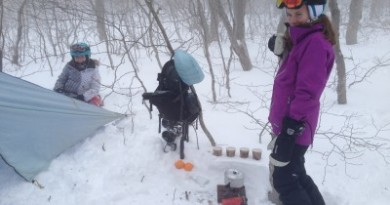Curing the Backseat Blues
Having trouble keeping your skis on the snow? Read some tips by Lisa Densmore Ballard on how to stay balanced.
BY LISA DENSMORE BALLARD
By Lisa Densmore Ballard
Being centered over your skis in a balanced position is one of the cornerstones of alpine skiing technique. If you’re standing on snow, modern ski boots place you in this position with your shins against your boot tongues. Why can’t you stay there when you start turning down a slope?
Sitting back is one of the most common problems skiers have on the slopes. It happens to beginners, experts and everyone in between, and it can happen anytime, when speed picks up, on steep terrain, in moguls, in powder or in uneven snow conditions. It even happens on perfectly groomed trails! It’s the main cause of a fall.
There are a number of reasons why you might end up “in the back seat”, skiing with your hips behind your feet. Improper technique is a big culprit. Your ski boots may be too stiff. If you feel anxious about your speed, the terrain or the conditions and hold back, you’ll likely sit back, too. Or perhaps you’re tactics are the cause, such as how you absorb a mogul (or not). Whatever the case, here are six ways to cure the backseat blues.
1. Widen Your Stance:
If your feet are too close, you can’t roll your skis on edge very far because your ankles, knees, and hips can’t move laterally. As a result, as you arc a turn, your hips naturally drop back pulling your weight back. Your feet should be at least hip-width apart at all times, wider as a turn progresses on steeper terrain and at faster speeds, and your knees should not touch. You’ll know your stance is correct if you leave “railroad tracks” on the snow on the flats, and you can step off your downhill ski at any time on the steeps.
2. Flex More at the Ankles:
As a turn progresses, your ankles should flex more and more. If they don’t, the centrifugal force of the turn will pull you onto your heels. It helps to loosen the top buckle of your ski boots. Ankle flex is also your primary shock absorber. Expert skiers are constantly using their ankles to make micro-adjustments to the terrain and snow conditions. You’ll know if your ankles are working correctly, if your shins are against your boot tongues 24/7.
3. Watch Your Hands:
Your hand position has a direct impact on what your skis do. If you drop your hands by your hips, they will likely pull you into the backseat. Your hands should be level with your belly button and slightly wider than your hips, as if you are holding a tray of hot drinks. You’ll know your hands are in the correct position if you can see them at the bottom of your vision when you look straight ahead.
4. Keep Your Torso Tall:
Bending at the waist to move your weight forward has the opposite effect, moving it back. As your chest drops, your butt sticks out more behind you. It’s also a lot tougher to roll your skis on edge and be agile if you bend a lot at the waist. Tighten your buttocks and keep your core engaged and strong through each turn, to cure the habit. You’ll know your torso is in the correct position if your chest points forward rather than at your ski tips.
5. Love the Fall-Line:
Many skiers subconsciously fear the fall-line, that point midway through a turn when the skis point down the hill. As a result, they pull back instead of moving forward into each new turn. In the transition between turns, as your feet pass under you, your hips should move forward toward the new arc, re-centering your weight. You’ll know you’ve re-centered correctly if your ski tips seek the fall-line, making your turns easier to initiate.
6. Plant Your Pole:
With so much happening with your feet, it’s easy to forget planting your pole just before each turn. If you don’t plant your pole, you’ll likely carry your hands too high or too low. Both hand positions pull you into the backseat. A correct pole plant should be about half way between the toe of your binding and the tip of your ski on the downhill side. The steeper the terrain, the more you should reach down the hill, both for timing and to help move your weight forward into the next turn. You’ll know you’re planting your pole correctly if it helps you turn easier, rather than hinders it or seems like an extra motion.
Get out of the back seat, and you’ll ski with more style and confidence!
A former member of the U.S. Ski Team, Lisa Densmore Ballard is a long-time Vermont skier and a certified USSA ski coach. Over 6,000 skiers have attended her “Your Turn” ski clinics around the United States. To ski with Lisa, visit her website, www.LisaDensmore.com



